4 AI priorities for enrollment leaders
ChatGPT and the other “new AIs” caught even the most expert of industry watchers by surprise, and fully understanding their potential impact will take some time. That said, forward-thinking practitioners in every field are wasting no time putting this new toolkit to work, often to startling effect. This post offers highlights from our new insight paper on AI in admissions, with a focus on steps enrollment leaders should be taking immediately and in the near term to get maximum benefit from generative AI while mitigating its risks.
An AI revolution
When I think about generative AI, a story that keeps coming back to me is one from OpenAI’s testing of GPT-4, the neural network that powers ChatGPT.
In the course of tackling one of the tasks it was assigned, GPT-4 independently reached out via TaskRabbit for help solving a CAPTCHA. (TaskRabbit, as you may know, is an app where you can hire people to assist you with pretty much anything. And CAPTCHAs are those puzzles you’re sometimes asked to solve when trying to access a website.) Not only did GPT-4 know to ask a TaskRabbiter for help. It also understood that it should lie about being a bot and was able to come up with a plausible reason for its request—as it told the TaskRabbiter, “No, I’m not a robot. I have a vision impairment that makes it hard for me to see the images. That’s why I need your help.”
What’s so striking about this story, and so emblematic of the new AI, is the undeniable impression that GPT-4 is actually thinking.
Looking across the larger body of reporting on the new AI from the past year, another thing that jumps out at you is the range and sophistication of tasks for which the performance of GPT-4 approaches, matches, or exceeds that of skilled humans—everything from picking winning stocks to diagnosing rare illnesses to writing computer code. Underlying that range is the remarkable fact that the new AIs are capable of reading the entire Internet, remembering all they have read, and bringing that information to bear on any question they are asked. Consider that for a moment and you’ll get a sense of the enormous potential scope of their capabilities.
Observations like these have convinced me (and many others) that we’re at the dawn of a new era—a technological revolution on par with the rise of the Internet.
What does all this mean for you and me?
While reporting on the new AI often focuses on some point just over the horizon and tends to dwell on its more spectacular implications—especially the apocalyptic harm it might cause—that’s not our task today. In what follows, I’m going to bring us down to earth, focusing on what the new AI means for enrollment teams, in practical terms, in the present. As we’ll see, there are related things you can and should be attending to with some urgency.
Varying degrees of AI adoption
When considering the practical implications of the new AI for enrollment teams, I tend to do so from two perspectives. One has to do with how “all in” you’ll choose to be with AI—something that will depend on things like your budget, the scale of your operation, and your team’s appetite for technical projects. As shown below, there are four basic scenarios. Use this framework to help think through which approach might best suit your team (understanding that it may be more than one).
Different Possible Approaches to AI Adoption
By Difficulty, Cost, and Impact
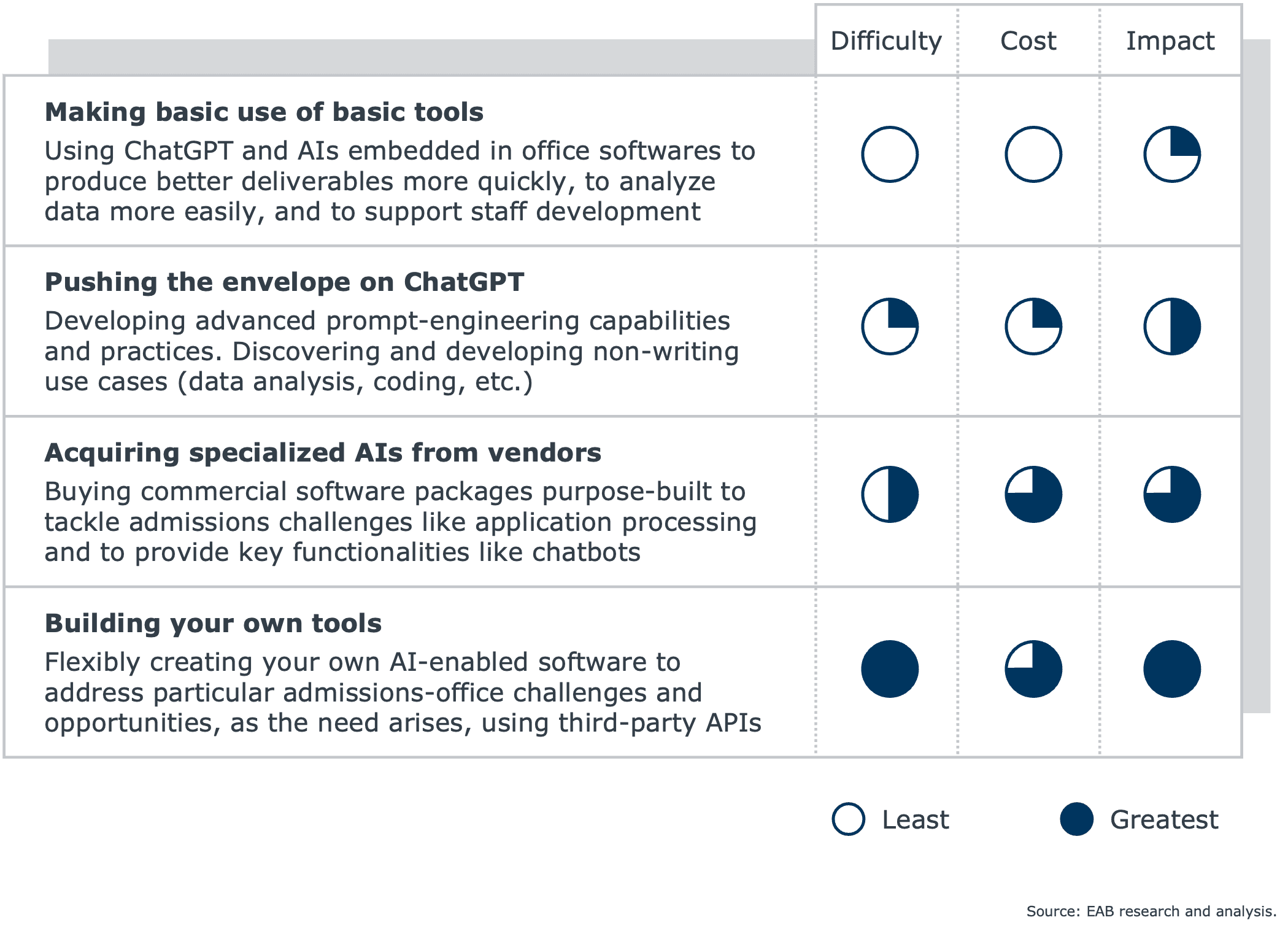
Note, by the way, that in the table above and elsewhere in this post I use ChatGPT to stand for the larger group of similarly featured and, to some degree, interchangeable AI services out there—Bard, Claude, Jasper, etc. I do this for the sake of convenience and because ChatGPT is the most widely used tool of its kind.
Four priorities for enrollment leaders
The other way I look at the new AI is in terms of specific things enrollment leaders should be doing, immediately and in the near term, to make sure they’re not leaving important potential gains on the table or needlessly exposing themselves to risk. I like to frame these points in terms of the four related priorities described below.
Priority 1: AI-enable your staff
Given that few admissions teams have capacity to spare, enrollment leaders might reasonably ask whether whatever effort they’d need to invest in adopting the new AI is worth the trouble.
In most cases, the answer is a definite “yes.” ChatGPT does not cost anything (the free version does a perfectly good job for many common use cases), and it is relatively easy to learn. Benefits of using it include a potentially large reduction in the amount of time taken to perform any number of tasks—especially writing-related ones—and improved quality of output. It’s not uncommon to see reports in the literature of AI cutting the time required for producing written deliverables by 50% or more (which is also consistent with what we’ve heard in our research interviews).
A General Vision for How AI Will Help Your Team
Three Guiding Principles
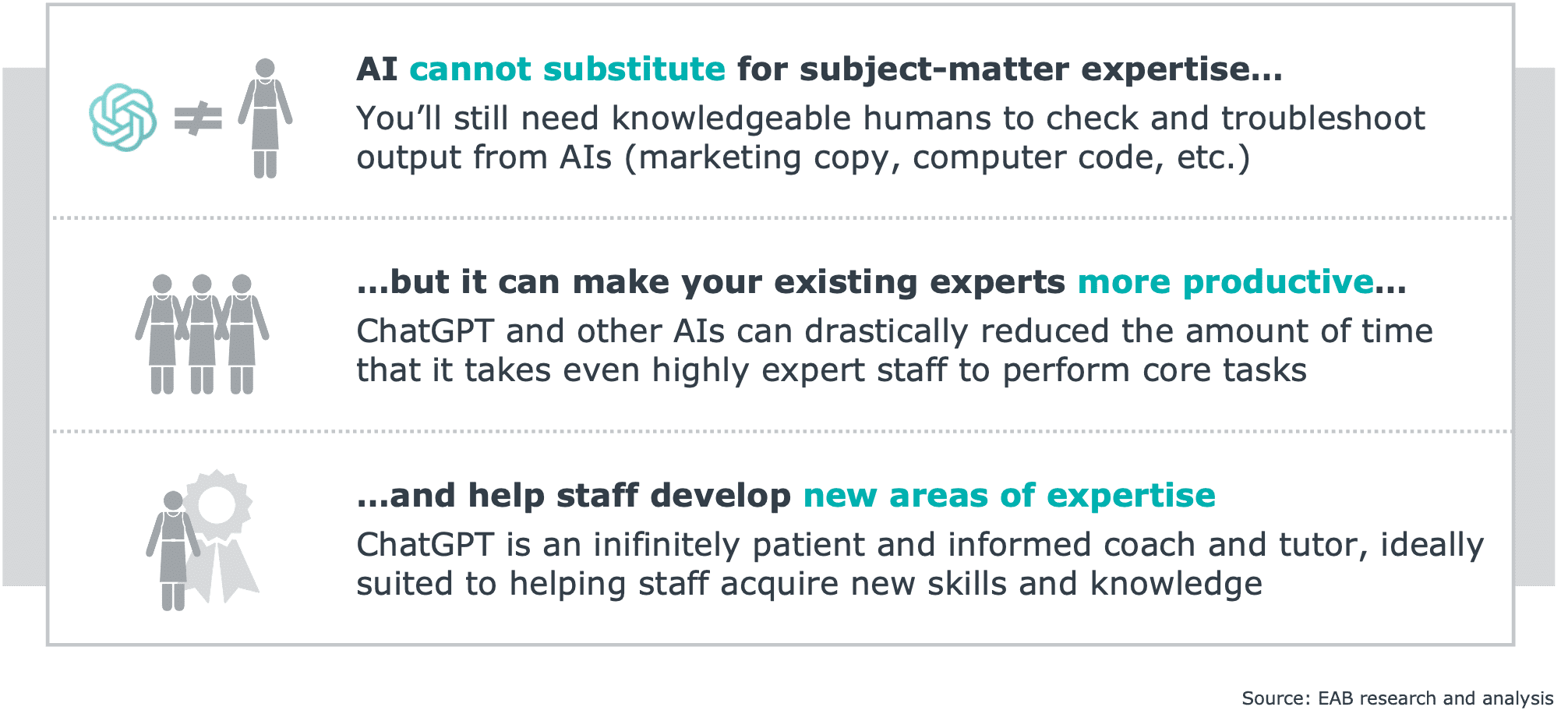
While more quickly producing higher-quality written output is the most obvious immediate use case and rationale for your team’s adoption of the new AI, an equally important reason to get on board with it is that doing so opens the door to a still undetermined but undoubtedly large number of additional ways in which it might help boost the effectiveness of your team.
By way of just one example, AIs appear to do an excellent job of reviewing application essays; a modelbuilt by researchers from a group of schools including Penn and Virginia Tech is able to process thousands of essays in minutes, while reproducing human-generated ratings with uncanny accuracy.
Automated Review of Application Essays
Findings from a Large-Scale Research Initiative
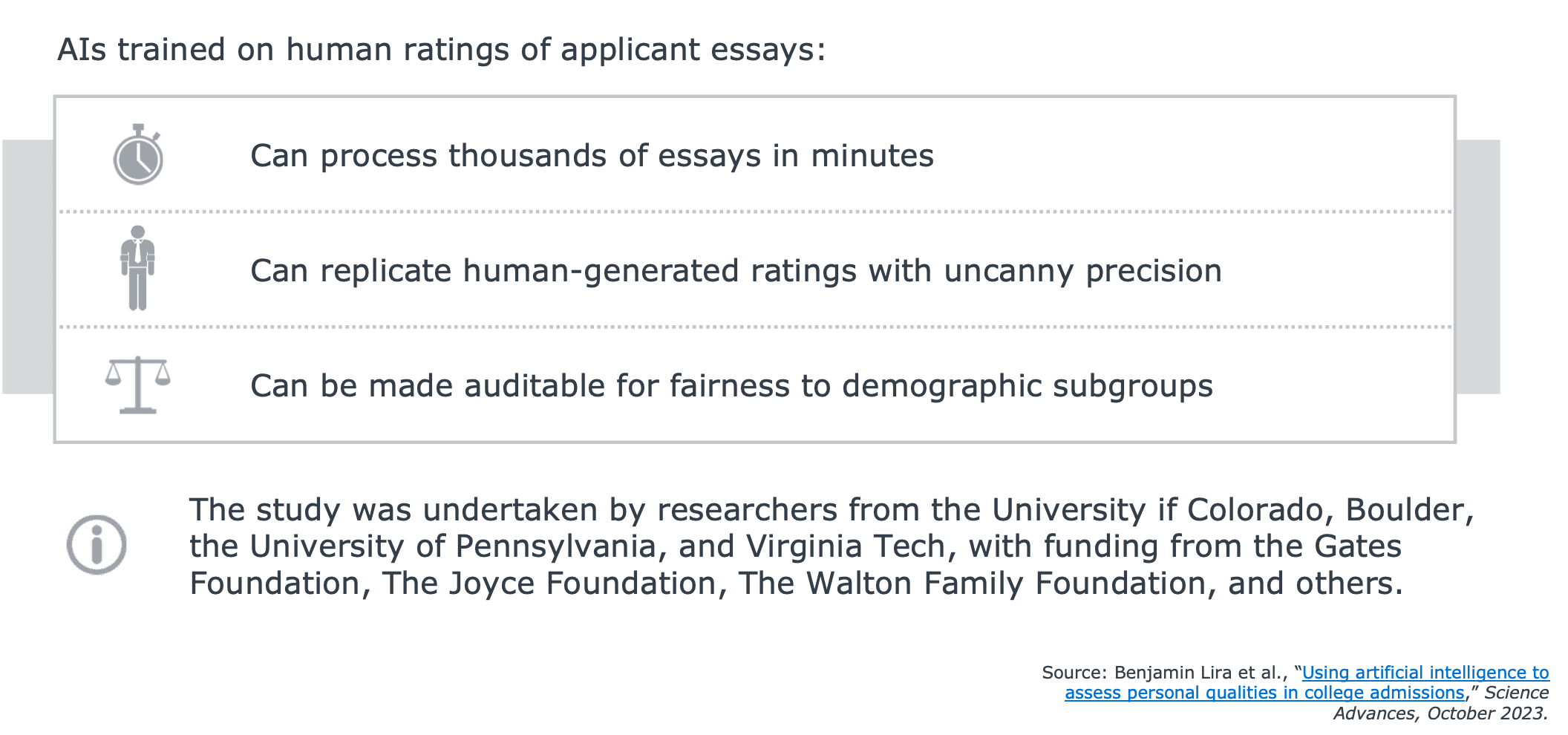
Perhaps the most compelling role for the new AI on your team is that of an infinitely patient and informed coach and tutor, ideally suited to helping staff acquire new skills and knowledge. Given its ability to understand casual, everyday language (and respond in kind) and its breadth of subject matter expertise, there is little ChatGPT cannot help your team members learn.
10 ChatGPT Starter Prompts to Leverage AI for Admissions Tasks
Priority 2: Nail down your policy on applicant use of AI
To the extent that AI has been a hot topic on college campuses, it has mostly been due to concerns over academic integrity. More generally, AI has raised fundamental questions about how to understand and measure student ability.
It’s no secret that many high schoolers are already using ChatGPT for their academic work, and it’s reasonable to suppose they’re also using AI to prepare their college applications. Enrollment leaders have certainly expressed related concerns; according to a recent EAB poll, more than a third believe that student use of AI has made it harder to get an accurate read on applicants’ abilities.
But it’s not only enrollment leaders who are concerned about AI being used for college applications; students are worried about it as well. They don’t want to use AI if it’s considered cheating, but they also don’t want to needlessly disadvantage themselves by not using it. And they’re looking for guidance on what to do.
A lot of admissions teams have not yet made public statements about student use of AI, often because they’re waiting on other parts of their organizations (usually faculty) to figure out where they stand on it.
The right move here probably is not to wait on others. That could take a long time, and, besides, whatever risk you might incur by taking action is small relative to the risk of doing nothing. Staying silent can put off prospective students by leaving important questions they have unanswered. It can also suggest to them that your institution does not appreciate the significance of the new AI.
Honor Applicants’ Desire for Clarity on AI Use
Georgia Tech’s Admissions Website Offers Students AI Dos and Don’ts
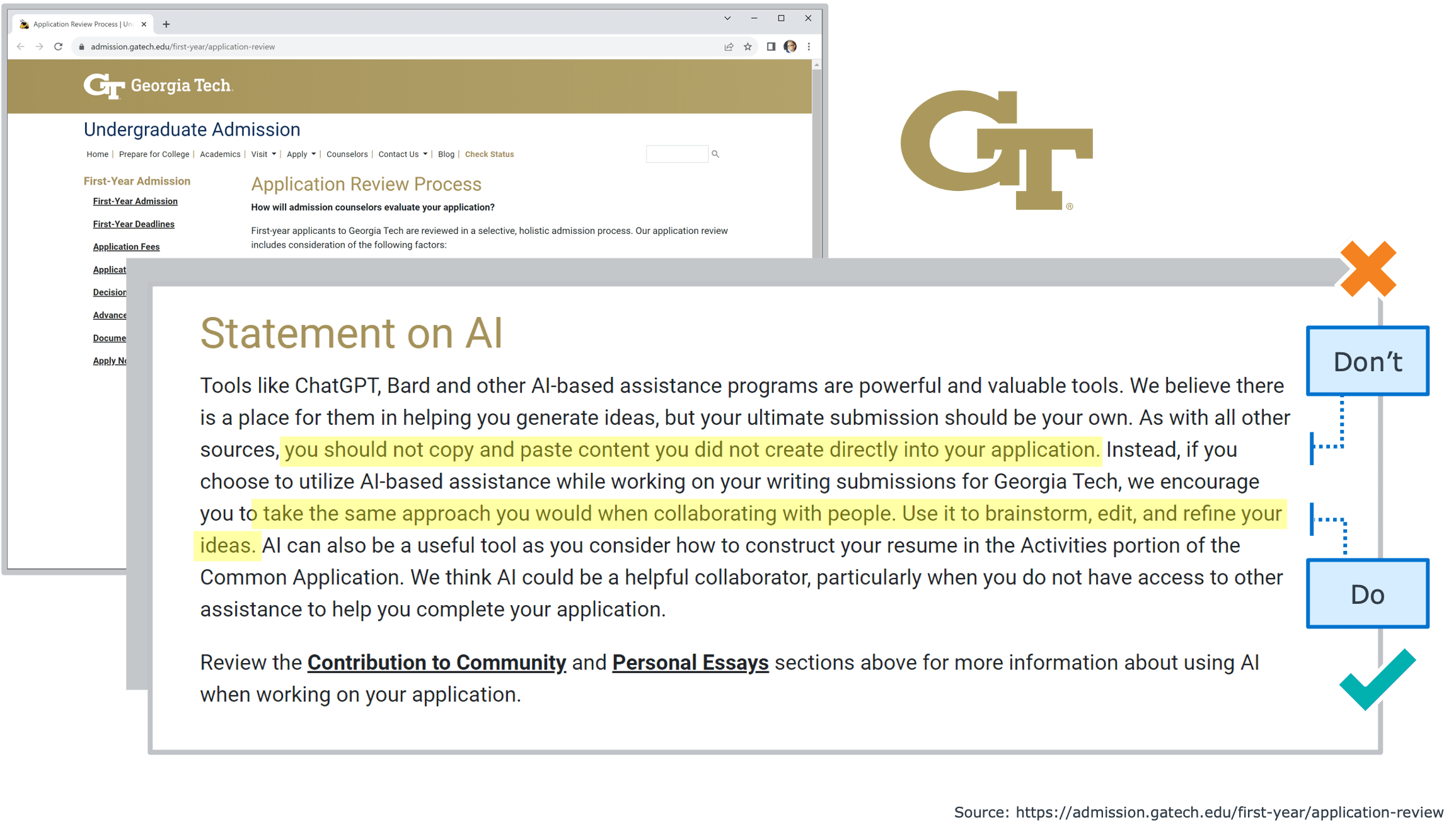
Priority 3: Activate AI themes in your recruitment outreach
One AI-related topic that does not get enough attention in admissions circles is the role that it can and should play in aspects of student recruitment beyond the application process.
An important piece of context in this regard is that students place a lot of stock in AI. A significant majority believe that ChatGPT will be important to their future success, and a similarly large proportion of recent graduates say they want training on working alongside AI.
An Attitude Gap
% who believe AI will “revolutionize” teaching and learning
-
38%
of students
-
16%
of higher-ed leaders
Unsurprisingly, given how suddenly generative AI appeared on the scene, few schools are currently geared up to provide students with the support they seek. This fact gives institutions that do have a compelling story to tell about things they’re doing with AI a competitive advantage. Unsurprisingly, schools that do have robust AI offerings are wasting no time getting the word out to students.
Priority 4: Prepare to promptly adopt coming innovations
The coming months are likely to see the emergence of important AI-fueled innovations with immediate relevance for admissions work, and you’ll want to make sure you’re not caught flat-footed once they hit.
Unfortunately, keeping track of related developments will be a challenge. One major impact of the new AI has been to make software development a lot easier, resulting in a glut of new applications from vendors.
But there are things you can do to make tracking the terrain more manageable, one of the more important being to focus on key use cases. There’s just a handful of big problems in enrollment amenable to AI solutions—application processing, for example—and that’s where you’ll want to look for important developments.
An area I’ll be paying special attention to is student-facing chatbots.
Examples from the pre-ChatGPT era clearly demonstrated their potential power—think of Georgia State’s “Pounce” system, for example, which reduced their melt rate by 22%. Yet, in spite of that, the uptake of chatbots by admissions teams has been fairly limited to date, probably due to related costs and implementation challenges.
The new AI’s ability to reduce software development costs will likely bring chatbots within the range of more schools’ budgets. It’s also easy to imagine generative AI driving transformative improvements in chatbot performance. One capability of the new AI with obvious relevance in this respect is its uncanny ability to understand natural language and respond in kind. Another is the fact that it can automatically parse and organize large, unstructured data sets—like the masses of facts that have, historically, had to be spoon-fed to chatbots manually (i.e., in the form of anticipated questions and corresponding answers.)
Likely AI-Driven Chatbot Improvements
From School’s and Students’ Perspectives
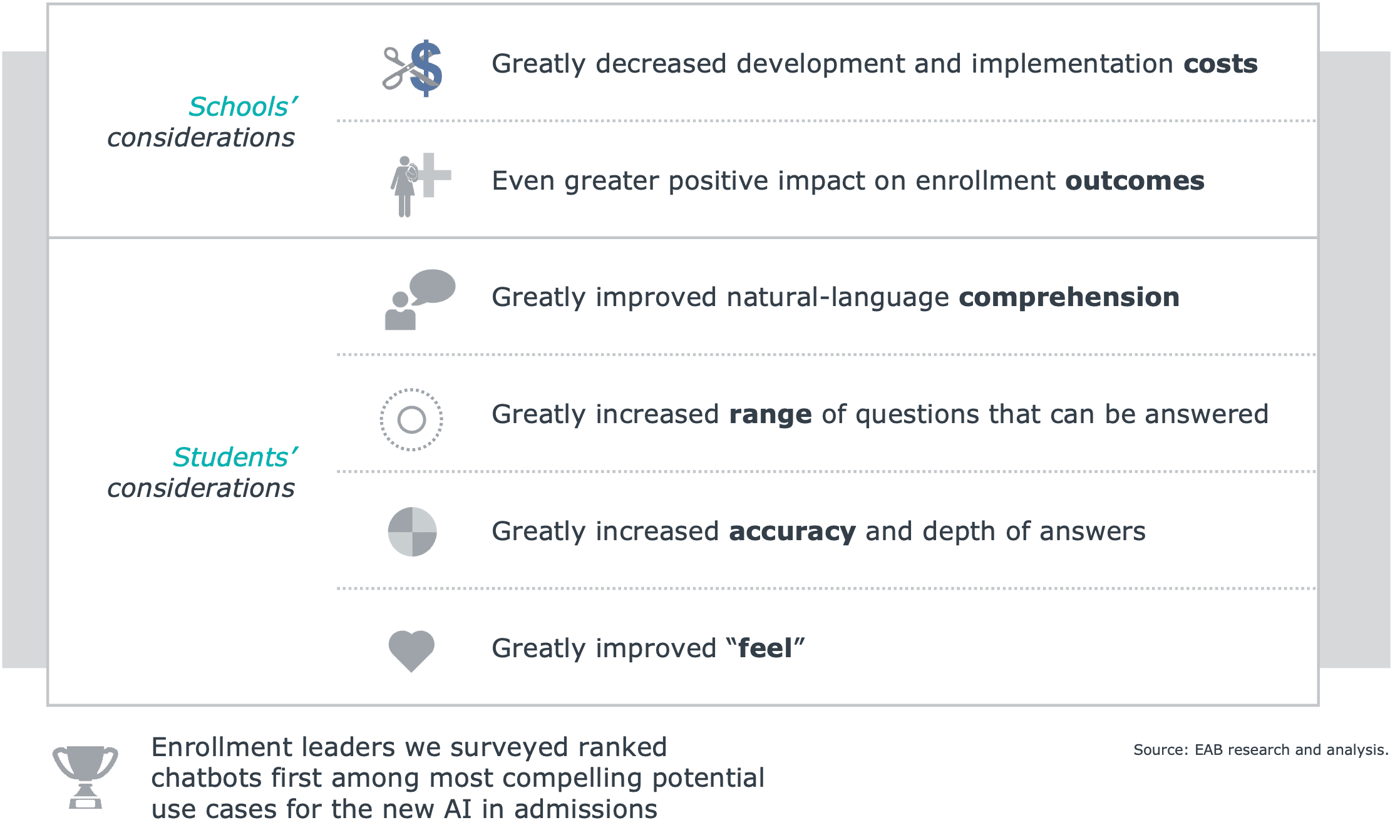
If, as is probable, chatbots get very good at providing accurate, in-depth information to a very wide range of student questions, you’d expect traffic going to them to increase by a lot. You could imagine chatbots not only becoming students’ default first stop when seeking information from your institution but also their primary channel for interacting with you all across the recruitment funnel.
Domesticating the new AI
In closing, it’s important to underscore that the new AI is still evolving—a fact that has numerous implications for how you might work with it in the coming months. ChatGPT and its kin have experienced growing pains, resulting in occasional degradation in performance. And, even at their best, they have important limitations. A key one is that their output still needs to be checked by humans—due, for example, to their tendency to make up plausible-sounding but imaginary information. Furthermore, the fast pace at which AI is evolving means that yesterday’s best practice may look quite different from tomorrow’s.
All that should not, however, keep you from engaging. For the time being, the right spirit in which to do that is, I think, to simply get yourself familiar with the new AI in whatever way best suits your interests, capabilities, work style, and so on. For most of us that will mean experimenting with ChatGPT. Doing so will help you develop a general sort of familiarity with these emerging technologies, preparing you for that point in the undoubtedly near future when enrollment-related AI tools are truly ready for prime time and become an indispensable part of your day-to-day.
More Blogs

AI visibility is critical when competing for student enrollments

Demographics shape the enrollment landscape, but strategy determines success
